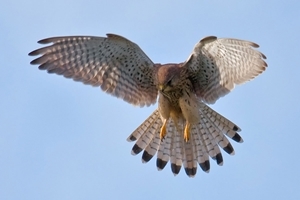Common kestrel
The Hovering Hunter, the Windhover.
 When I was a child, my only way of enduring long car journeys was the prospect of counting kestrels hovering beside the motorway, but recently I have noticed they are less frequent along the busy roads in Hampshire and seemingly more abundant in the farmed landscape, which is an indicator that farmland is providing well-managed foraging habitats abundant in prey.
When I was a child, my only way of enduring long car journeys was the prospect of counting kestrels hovering beside the motorway, but recently I have noticed they are less frequent along the busy roads in Hampshire and seemingly more abundant in the farmed landscape, which is an indicator that farmland is providing well-managed foraging habitats abundant in prey.
For the past few months, I have been out and about on the farms that are a part of the Martin Down and Allenford Farmer Clusters, which I am the Facilitator for, either doing butterfly surveys, monitoring ink footprint tunnels surveying the presence of hedgehogs, or conducting autumn grey partridge covey counts, which has given me days of catching sight of these beautiful falcons going about their business above me, and I have even had the pleasure of watching a pair rear and fledge their young from a nest box put up on the side of a barn.
The name kestrel is given to several different members of the falcon genus, Falco, but I focus this Species of the Month on ‘our’ kestrel, known elsewhere in its range as the common kestrel (Falco tinnunculus). A magnificent small falcon, roughly the size of a magpie, weighing up to 250g with a wingspan of about 75cm, which has a light brown plumage with dark spots. Males have a grey-blue head, while females are all brown with pointed wings and a tail that appears long in flight and fan-shaped when the bird is hovering.
In medieval falconry, our common kestrel was reserved for the knave, reflecting its lowly status, but they are far from lowly; they are beautiful birds, majestic in flight, especially when hovering – which is where their alternative name ‘Windhover’ comes from. Kestrels are most easily distinguished by their typical hunting behaviour, which is to hover into a slight headwind at a height of around 10-20 metres over open country and swoop down on prey, usually small mammals (mainly voles), lizards, earthworms, or large insects.
The kestrel’s ability to hover like this is one of their successful hunting strategies, the other being to sit and wait, but hovering above is also combined with an added ability in their armoury to increase the likelihood of catching their prey. Small rodents mark their environment with urine, which allows them to navigate familiar territory and to communicate with one another, but this practice has a deadly side effect. Those marks are visible in ultraviolet light, which is used by kestrels to trace their prey to source like a road map, and home in on their prey for the kill!
However, even with these brilliant hunting skills, the kestrel is on the Amber list of Birds of Conservation Concern, due to the moderate decline of the UK breeding population, with an estimated population of around 45,000 pairs. But the reason for the decline since 2005 has not been identified, and conservation projects are under way to better understand the causes.
So, when you next see this small falcon riding the wind, watching intently, still of head, at the rough grassland below, have a thought to the Windhover and what might be on the menu below.
The Windhover
Gerard Manley Hopkins (1844-1889)
I caught this morning morning's minion, king-
dom of daylight's dauphin, dapple-dawn-drawn Falcon, in his riding
Of the rolling level underneath him steady air, and striding
High there, how he rung upon the rein of a wimpling wing
In his ecstasy! then off, off forth on swing,
As a skate's heel sweeps smooth on a bow-bend: the hurl and gliding
Rebuffed the big wind. My heart in hiding
Stirred for a bird,—the achieve of; the mastery of the thing!
Brute beauty and valour and act, oh, air, pride, plume, here
Buckle! AND the fire that breaks from thee then, a billion
Times told lovelier, more dangerous, O my chevalier!
No wonder of it: shéer plód makes plough down sillion
Shine, and blue-bleak embers, ah my dear,
Fall, gall themselves, and gash gold-vermillion.
Megan Lock
Advisory
Photo credit: Andreas Trepte